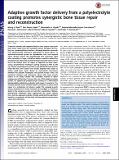| dc.contributor.author | Seeherman, H. J. | |
| dc.contributor.author | Nevins, M. | |
| dc.contributor.author | Spector, M. | |
| dc.contributor.author | Shah, Nisarg J. | |
| dc.contributor.author | Hyder, Md Nasim | |
| dc.contributor.author | Quadir, Mohiuddin Abdul | |
| dc.contributor.author | Dorval Courchesne, Noemie-Manuelle | |
| dc.contributor.author | Hammond, Paula T. | |
| dc.date.accessioned | 2015-04-28T20:23:57Z | |
| dc.date.available | 2015-04-28T20:23:57Z | |
| dc.date.issued | 2014-08 | |
| dc.date.submitted | 2014-05 | |
| dc.identifier.issn | 0027-8424 | |
| dc.identifier.issn | 1091-6490 | |
| dc.identifier.uri | http://hdl.handle.net/1721.1/96834 | |
| dc.description.abstract | Traumatic wounds and congenital defects that require large-scale bone tissue repair have few successful clinical therapies, particularly for craniomaxillofacial defects. Although bioactive materials have demonstrated alternative approaches to tissue repair, an optimized materials system for reproducible, safe, and targeted repair remains elusive. We hypothesized that controlled, rapid bone formation in large, critical-size defects could be induced by simultaneously delivering multiple biological growth factors to the site of the wound. Here, we report an approach for bone repair using a polyelectrolye multilayer coating carrying as little as 200 ng of bone morphogenetic protein-2 and platelet-derived growth factor-BB that were eluted over readily adapted time scales to induce rapid bone repair. Based on electrostatic interactions between the polymer multilayers and growth factors alone, we sustained mitogenic and osteogenic signals with these growth factors in an easily tunable and controlled manner to direct endogenous cell function. To prove the role of this adaptive release system, we applied the polyelectrolyte coating on a well-studied biodegradable poly(lactic-co-glycolic acid) support membrane. The released growth factors directed cellular processes to induce bone repair in a critical-size rat calvaria model. The released growth factors promoted local bone formation that bridged a critical-size defect in the calvaria as early as 2 wk after implantation. Mature, mechanically competent bone regenerated the native calvaria form. Such an approach could be clinically useful and has significant benefits as a synthetic, off-the-shelf, cell-free option for bone tissue repair and restoration. | en_US |
| dc.description.sponsorship | National Institutes of Health (U.S.) (Grant R01 AG029601) | en_US |
| dc.description.sponsorship | National Institutes of Health (U.S.) (Grant R01 EB010246) | en_US |
| dc.description.sponsorship | National Institutes of Health (U.S.) (Grant P30 CA014051) | en_US |
| dc.description.sponsorship | Natural Sciences and Engineering Research Council of Canada (Fellowship) | en_US |
| dc.language.iso | en_US | |
| dc.publisher | National Academy of Sciences (U.S.) | en_US |
| dc.relation.isversionof | http://dx.doi.org/10.1073/pnas.1408035111 | en_US |
| dc.rights | Article is made available in accordance with the publisher's policy and may be subject to US copyright law. Please refer to the publisher's site for terms of use. | en_US |
| dc.source | National Academy of Sciences (U.S.) | en_US |
| dc.title | Adaptive growth factor delivery from a polyelectrolyte coating promotes synergistic bone tissue repair and reconstruction | en_US |
| dc.type | Article | en_US |
| dc.identifier.citation | Shah, N. J., M. N. Hyder, M. A. Quadir, N.-M. Dorval Courchesne, H. J. Seeherman, M. Nevins, M. Spector, and P. T. Hammond. “Adaptive Growth Factor Delivery from a Polyelectrolyte Coating Promotes Synergistic Bone Tissue Repair and Reconstruction.” Proceedings of the National Academy of Sciences 111, no. 35 (August 18, 2014): 12847–12852. | en_US |
| dc.contributor.department | Massachusetts Institute of Technology. Department of Chemical Engineering | en_US |
| dc.contributor.department | Massachusetts Institute of Technology. Laboratory for Manufacturing and Productivity | en_US |
| dc.contributor.department | Koch Institute for Integrative Cancer Research at MIT | en_US |
| dc.contributor.mitauthor | Shah, Nisarg J. | en_US |
| dc.contributor.mitauthor | Hyder, Md Nasim | en_US |
| dc.contributor.mitauthor | Quadir, Mohiuddin Abdul | en_US |
| dc.contributor.mitauthor | Dorval Courchesne, Noemie-Manuelle | en_US |
| dc.contributor.mitauthor | Hammond, Paula T. | en_US |
| dc.relation.journal | Proceedings of the National Academy of Sciences | en_US |
| dc.eprint.version | Final published version | en_US |
| dc.type.uri | http://purl.org/eprint/type/JournalArticle | en_US |
| eprint.status | http://purl.org/eprint/status/PeerReviewed | en_US |
| dspace.orderedauthors | Shah, N. J.; Hyder, M. N.; Quadir, M. A.; Dorval Courchesne, N.-M.; Seeherman, H. J.; Nevins, M.; Spector, M.; Hammond, P. T. | en_US |
| dc.identifier.orcid | https://orcid.org/0000-0003-1727-5732 | |
| dc.identifier.orcid | https://orcid.org/0000-0002-5568-6455 | |
| dspace.mitauthor.error | true | |
| mit.license | PUBLISHER_POLICY | en_US |
| mit.metadata.status | Complete | |
